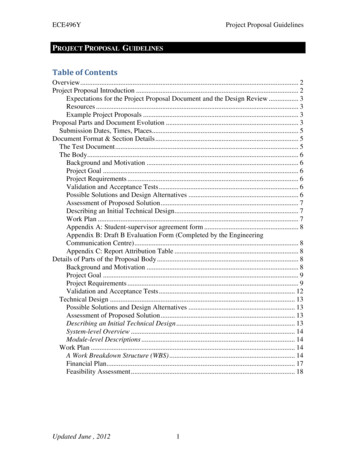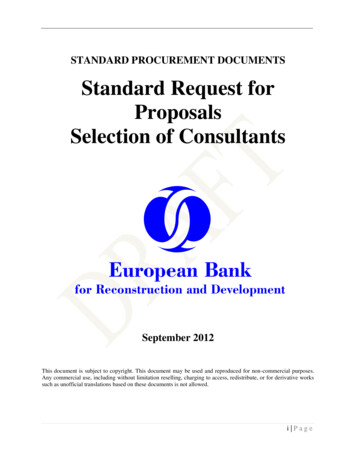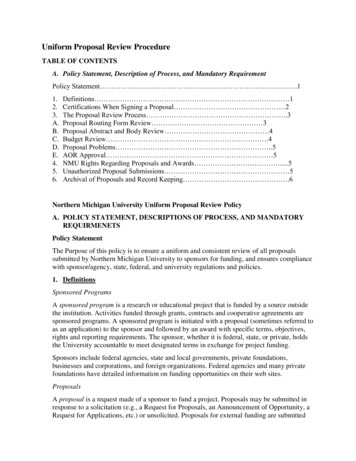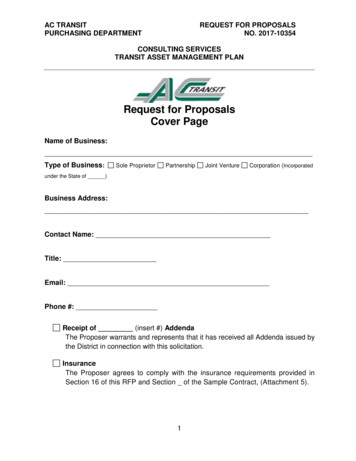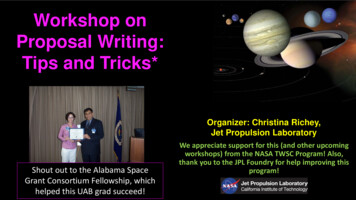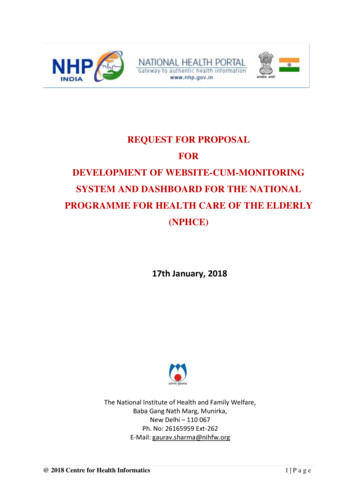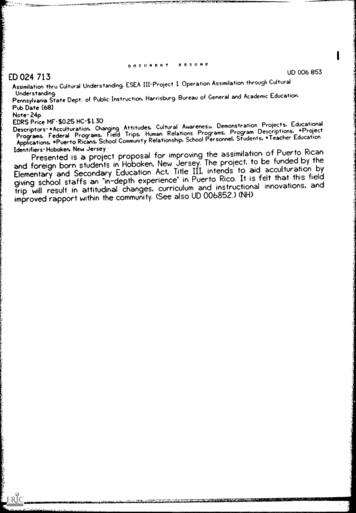
Transcription
DOCUMENTRESUMEED 024 713UD 006 853Assimilation through CulturalAssimilation thru Cultural Understanding. ESEA III-Project I. OperationUnderstanding.and Academic Education.Pennsylvania State Dept. of Public Instruction, Harrisburg. Bureau of GeneralPub Date I681Note- 24p.EDRS Price MF- 0.25 HC- 1.30Projects, EducationalDescriptors-*Acculturation. Chansing Attitudes, Cultural Awarenes, DemonstrationProgram Descriptions, *ProjectPrograms, Federal Programs. Field Trips, Human Relations Programs,Personnel, Students, *Teacher EducationApplications. *Puerto Ricans, School Community Relationship, SchoolIdentifiers-Hoboken. New JerseyPuerto RicanPresented is a project proposal for improving the assimilation of fundedby theand foreign born stusdents in Hoboken, New Jersey. The project, to beacculturation byElementary and Secondary Education Act, Title III, intends to aidthat this fieldgiving school staffs an "in-depth experience in Puerto Rico. It is feltinnovations, andtrip will result in attitudinal changes, curriculum and instructionalimproved rapport within the community. (See also UD 00b852.) (NH)
U.S. DEPARTMENT OF HEALTH, EDUCATION & WELFAREOFFICE OF EDUCATION11\ THIS DOCUMENT HAS BEEN REPRODUCED EXACTLY AS RECEIVED FROM THEPERSON OR ORGANIZATION ORIGINATING IT.POINTS OF VIEW OR OPINIONSi STATED DO NOT NECESSARILY REPRESENT OFFICIAL OFFICE OF EDUCATIONPOSITION OR POLICY.kNOECLIDTTOORi'9/00340/0434%TH RUTULTHANE.nED11351IUDOMOBOARD OF EDUCATIONHOBOKEN,NSJ JERSIM
TITLE III - PROJECT IHOBOKEN, NEW JERSEY2.PERATZA 4SSIMILV,TON THROUGHmama UNDERSTANDINGABSTR6CTA.B.C.staffThis proposed project yill train and retrain schoolstrucand thraugh involvement affect the cammunitY powerture in order to understand the multi-aultural aspects ofour Puerto Rican, Foreign Born and all culturally unassimtheilated groups. By developing the positive values ofvarious groups so that they can be reflected in the schoolcurriculum and life of the community, a rapport will beproduced which will develop the climate necessary for assimilation.A growing percentage of Puerto Rican children (3% in 1953to 3)#% in 1967) coupled, with a Foreign Born group (9)4%representing 33 countries) has produced a situation inwhich over 43% of our sdhool population is culturally unassimilated and linguistically handicapped. The magnitudeof the problems produced by this situatian is such that it57% ofhas affected the learning climate for the remainingour student population. This problem has had its impacton the non-public schools, particularly at St. Joseph'sSchool, which now has an enrollment of 50% Puerto Ricanchildren.We feel that this innovative approadh to assimilation bygiving school staffs an in-depth experience in understanding the culture of Puerto Ricans by an "on-site confrontation at the primary source" will produce the needed changesin attitudes, curriculum, and approaches nteded to effectuate assimilation.Puerto Rico is closer to Hoboken and New Jersey than manyparts 'of our continental United States. This availabilityof visitation will be utilized as part of the strategy tobreak down many of the negative middle-class attitudes heldby staff and community whi2h are retarding assimilation.
D.A voluntary anthself-financed trip to Puerto Rico in Normber, 1966 by 90 representatives of the sahool staffs andcommunities of Hoboken, Jersey City, Union City, Vinelandand Jersey City State College, produced the kind of understanding vitally needed in this area. The interest stirredin.many of the New Jersey communities facing similar problems coupled with the positive reaction in Hoboken has encouraged us to develop this project.It is thus proposed this unique community become theApgsitory, and Expository site for application of research and experimentation in the area of concern.B.F.Our objectives include, developing understanding, of theour schools, identification,ured childrgnexplument of schoolential,ort needed to permit enrichment of tot lture of a community, dev lo ment of the ins ructionaue re uired, prepare knd Grain s affers to meet the needs of classes withd lin uisun ssimilatedof cultur17 .4Andicapped ChilAren, serve as a Mo el Demonstrat gnjiaboratory for the development of practices and procedures for communities in. the State and Nation who havesimilar problems.During phase one of this project, a Task Force will beformed to visit, study resnarch, and organize all theprocedures which will evenkmally be used to meet ourobjectives.Phase two, the operational phase, will utilize the suggested pilot programs as developed from the planning phase./t is appr Int, at this time, that techniques and procedures suggested from the planning phase, will encompass twoyears of application and operational phasing.
EAALII1.NARRATrIA21149.2ammuLtaA.The industrial seaport City of Hoboken, New Jersey, is aneof the most densely populated communities in our nation,with a 1960 Census population of 48,141 ltving in a milesquare area.More recent (1965) CAP survitys indicate thepopulation is now 49,451.Hoboken truly reflects an urban multi-cultural populationdistribution.The following "Household Population Dis-tribution" statistics indicate the extraordinar14 highpercentage of Puerto Rican families, whidh, if coupledwith the large number of Foreign Born families point upthe magnitude of this problem.HOUSE FOPULATION DISTRIBUTION(CAP Survey)There are 3,800 Puerto Rican households out of the 15,450listed households in our community.II.B.See attached mapA.Hoboken is ideally located in the North Eastern portion ofthe State of New Jersey.It is at the bub of the greatNetropolitan Cultural Center served by :New York City andHudson County.Within a radius of 10 miles are the doorsof the richest educational and cultural institutions ofour nation.Hoboken possesses 6 public elementary schools (K-6), 2public Jr. High schools (7-9) and 1 public Senior Highschool (10-12).In addition, there are 6 non-public ele-mentary schools (1-8) and two private academies (9-12).Stevens Institute of Technology graces our eastern border-
AREATO BE SEMI) BY ADM.! TITLE III PROGRAM;&WE MN QVJersey'City3611112Uudson ColintyUnion CityHttels can***1StCounty/13. PatersonPassaic CountyPerth Amboys.494164.1110:44'OtMiddlesex CountyNV AP414%,10. Ves.; BriviswickMiddlesex County"Trentonirtercer Cowity'OA\01/ 'Y"(PIMb441i7Camden County8. /,Cihrt.ftio;4.--.Cumberland CountyDoveri,.?Norris Countyr414CPCSt.tSWAMt/al' yWOOLNINEINBRUNSWICKPENNSYLVANIAHOBOKEN :c. ,. .3 JERSEPERTH AMBOY//tig4q1.0%0 41/1Ji:#17"1.Awoman*PHILADELPHIA. .Rsearch for beteS Opals41ClAIVAlitgmlietj.At4DENIDor",-11,k't.Shehll SIIPuert.o Rte. \east-on141s3ttehuiettsWoo HavenConnecticutBuffaIoDELAWAltaNed yerkSytAcctsA,wegi york,:34 fr. aaa'.''?ovireeme rers2.emorailoomi.MS.13 din AA. .11 ,111304.car.Mt:. #11.111111,.Smsonrmlommworm. ow* raw amp .few 14, owls. 00.t.111.0 01311111 0111113
line; the third oldest public library in the State,Hoboken's Public Library, is part of our heritage;in 1885, isThe Hoboken Industrial School, establishedthe precursor of the modern High School Industrial ArtsCurriculum, and Vocational and Technological Bigh Schools,ii another cultural heritage of this seaport community,Religious and Civic Institutions and groups are numerausand concerned;Municipal officias are newly alert andfunctioning andthe CAP organization is well structured,cooperative.College are adJersey City State College and St. Peter'sjacent to our boundaries, as are the Colleges and Universities of Paterson, Montclair, Setan Hall and FairleighDickinson, within the 10-15 mile radius in New Jersey.Across our eastern border, the Hudson River, within minutesand shorter miles are the myriad riches of New York City'seducational and cultural institutions.In view of its size,facilities, location and needs, it is significant to notedemanthat the Bbboken School Community could serve as astration. model where researal and techniques can be appliedmulti-cultures on ato the problems posed by the impact ofcommunity.B.School surveys (LEA and Non-Public), Community surveys(CAP), have identified those who are not functioning inlight of their evident potential.Reasons for this have been analyzed and are listed inorder of greatest impact.
-3-1.Communication disabilities2.Limited educational achievement3.Unemployment4.Inadequate housing5.Finances6.Multi-cultural confusionIndividuals may fall in one of these categories, Vat moreoften you will find a combination oUtwo or more withsome covering the complete gamut.These community surveys have indicated that over 70% ofHoboken's population can be classified as culturally and/orlinguistically handicapped.In. view Of the above facts andcoupled with the school statistics, which indicate a growingpercentage of children from these groups, the highest prior-ity has been assigned to a program which will significantlyaid them.C.Evaluations of our past and current programs, discussionswith students, staff, community and business representativeshave all indicated that the traditional approadhes to theproblems caused by multi-aultural confusions heme not effectively aided in the attainment of the goals of coMmunity andsschoOl assimilation.A new and innovative strategy can andmust be employed which will. attack the basic resistive forcesinhibiting this assimilation process.We see these forces asmiddle class values and attitudes; dearly hsld by school staffand the power structure of the community, as well as the values and attitudes of the Pusrto Rican and Foreign Bornfamilies.
fr--4-will proInsights and experiences must be provided whichattitudes before asstmduce the needed changes in thesegrowingilation can take place. Our problem is an everone as illustrated by the following:1.In 1953 when this problem first came intofocus, our new Puerto Rican citizenry composed but 3% of our school population, whereas today it has risen to 34%. Concomitantlyfromour Foreign-Born student population rose2.2% to 9.4%, thus within the period of 13years our educational program has absorbeda foreign language oriented student population of 43%. The traditional, but economically limited measures taken during this period made strides towards but could not makea significant breakthrough in solving theproblems inherent in the community and educational structures.Haw then can the breakthrough be made?We propose to devel-the Puerto Ricans,op new methods and techniques to encourageHoboken tothe Foreign Born and the Native Born pupils ofreach high standards of achievement, and we propose to probothvide ways for assimilating a multi-cultured population,the communityin the educational program and in the life ofitself.social, culturalWe plan to place positive emphasis on theracial, culturaland intellectual heritage of the variousand national groups making up the City of Hoboken.utilizing and coWe hope to find new ways of identifying,Federal resourcesordinating community, county, State andconcerned with meeting the needs of children.through theBy using a multi-faceted approach we intend,educational program, to assess and develop human potential
THE CIRCLE-of f- EDUCATIONTEACHINGAMERICAN'CULTURE
-5.and thereby enriching the lives of these individuals aswell as aiding them in contributing to the good life ofthe community in which theY will ltve and work.Th1s will enable Hoboken, through its schools not onlyto resolve its own purposes but also to serve as a modeldemonstratin laboratory for other communities.We believe that the school, as the one community institution that comes in close and prolonged contact withchildren and youth, enjoys a unique anestrategic responsibility and opportunity for assisting culturally unassimilated youtY,Theschool can make a,direct and significantcontribution in a community-wide program aimed to identifyand assist those who have not been permittedor encouragedto become participating an&contributing members of our.schools and community.It is fully recognized that there are limitations on what.the school can accomplish:with and for culturally unassim-ilated yout&During the.,life span of these children, theschool exerts its influence only after much learnIn;already taken place.cannot be forldicoming,sSuccess'in.attaining full* assimilationwithout the recognition and involve- .ment of other powerful forces.The family, housing, neigh-borhood, peer group, labor and business organizatians,municipal, state and federal agencies a:mass media areall forces which must be mobilized in order to maximize anddirect all positive influences toward the solution of thisproblem of effectively absorbing many culturally differentgroups into a community.
-eimessamoluMammliv aliellow.iessmegoregistraltiMfthowenaragessamar Eberoaftrole alosawftEsiaCcillw Courses%der PrivilegedO.LO.arm City%ion CiteEat lironsolok11104.0.1.s.c.1114Pet *AO.Forth AboyPatapscoVinslandCamdsmTrentonzsgsAkt jaigFlymelameSeainerConversationalSpanisb ClassesCultural Seminarsheaven, Conn.RATION On dHoUoke, Mass.FA1BIWA Wit %at,eoston, Mass.VOrchestar, Mass.Miami, ?la.TexasCaliforniaCimadaof InstructlaUniversitt ofPuerto RicoNJ. Dep t. akitiraklahttirMIStatKomiN.Y.U.ColdnbLaUnin of P.R.jiiblic Information Mediabollsing.A.GA111hostsMiNUARidJersey journalHudson h & VslfareLionsFraternal GroupsLiployment'AMU SSIMIL A1:04PROCESS
In addition to the above mentioned forces which must bebrought to bear on this problem, our situation clearlydemands involvement of the Commonwealth of Puerto Ricoand all its agencies particularly the Department ofInstruction.Our previous experiences with the Depart-ment of Instructian throligh the teacher-exchange j *ngramand the Fly-In Seminar have demonstrated that effectivebreilkthrough can only be'made by a two pronged attack de-veloped cooperatively by our school community and the.Puerto,Rican Commanwealth.The critical areas.of Teacher-Staff understanding and training, curriculum pl6nning and development, and techniques of*orientation for life in the cantinental U.S. are all.areasWewhich must be developed and implemented cooperatively.are extremely optimistic about achieving success in thisphase since the officialsin Puerto Rico have indicatedtheirfull agreement as to procedures and our cooperative roles.The school agency Can achieve its maximum effectivenessonly to the degree that it satisfies four major needs:FirAthat the teachers and educational staff fully understand theproblemi and their roles.Second, that the curriculum of theschool includei aims, methods, materials and climate conduciVe tc5 learning and i.e. the assimilation proceSs.Third,if ancillary services, including testing, counseling, jobplacement, case work .and health services, are available andaccessible to these children at the time of need; and Fourth,that the school truly becomes a member of the community teamand meshes its services with other public and private agencies
.7that can and will work closely with the culturally unassimilated children and their families.To date, the use of our traditional school methods (specialized and orientation classes, individual instruction, cultural assembly programs and trips, pupil-parent interviews)plus a few attempts of experimentation (Teacher-Eichangeprogram with Puerto Rico, Fly-In Seminar tO Puerto Rico,Pilot-Teacher training program with Jersey City StateCollege, new curriculum materials) have given insights andhave indicated new approaches toward a more rapid and thorough process of assimilation for all.These approadhes, how-ever, need to be implemented to a degree far beyond the localcommunity's present financial ability to support.We believethat the impact of this proposed three year project will besuCh that the local Board of Education will be in a positionto continue the proven techniques developed.In Addition, situations exist to indicate similar pocketsare emerging throughout communities in our State of NewJersey, as well as other states.Research and experimen-tation have taken place in scattered locations throughoutthe country.We feel our situation and needs could justi-fiab/y be utilized as a "MODEL DEMONSTRATION LABORATORY" inwhich the best of this research and experimentation could beapplied in the practical arena.It is known that our Puerto Rican concentration of studentsis proportionally the highest of any place outside of theIsland itself.Officials from the Commonwealth of PuertoRico, Department of Instruction, have visited our schoolsand studied our attempts to resolve the school and community
.8.Puerto Rican relationships.Admittedly, the promo designedis superior in breadth and depth, yet it still falls shortof adhieving the goals of full assimilation.Added to the Puerto Rican assimilation problem is an additional 9.4% of our student body whc are fbreigri-born andlinguistically handicapped.Techniques developed underthis project could be applicable for their.assimileitAonas well.We maintain that the remaining 57% native born studentswill measurably advance educationally in direct proportionto the alleviation of the stresses which a multiplicity of"LANGUAGE BARRIER" groups create.In addition, waTeel thatthe native born and assimilated segment of our sdhool population has a responsibility to assist in the tottlAssim-nation process.Use of this group to be part of "Cdnver-sational" teams to talk with the linguistically hanqicappedin a planned program and to convey the "rules of the game".i.e. the do's and the don'ts of successful partiel.p*timain our culture, should xlsult in effectively acceleratingthe assimilation process by giving needed insightvto allchildren.We also maketheassumption that cultural understanding andi.e. chant* attitudes, will result in a higher tzacher retention rate for urilan communities or inner city situations.We intend to analyze the results in this light.Because of the nature of our needs and the ideal settingprovided by this community, we propose to become the "REPOSITORY AND EXPOSITORY SITE" for uniting the scattered research
-9and eXperimentation and to apply it for the developmentof new techniques and materials as related to the problemof the Culturally-unassimilated add Lirguisticallyhandicapped.40
III. OB3ECTIVES1.Develop for staff an improved understanding of theculture, background and ltves of the Puerto Rican andForeign Born students, and the roles the staff must assume in the assimilation process.2.Identify, assess and further develop the human po-tential of our culturally unassimilated and linguisticallyhandicapped children.3.Develop a classroom and community rapport to permitthe cultures of all groups to stimulate and enrich thetotal culture of this community.4.Develop an effective curriculum with specifie'instruc-tional materials and techniques wtich will serve as.thecatalyst for the assimilation process.5.Prepare and train present staff and prospecttve teadh-ers to adequately meet the needs of classes composed ofhigh percentages of linguistically handicapped children.6.Utilize all resources available to the community in-cluding State and Federal programs, which will enable thePuerto Rican and Foreign Born population to effecttvelytake their place as fall participating and contributingmembers of our ""
7.To serve as a demonstration arena for the dovelopmentof now practices and procedures in this area and fartherserve other communities in the State and Nation who havenAgias sanA prnhloms.
-,-12-D.Hoboken, New Jersey is an old city (111 years) whichhas and is suffering fram the ills and problems facing mosturban centers today. A fleeing middle-class, loss of largebusiness corporations to the suburbs, rising costs of minicipal government and concomitantly a high tax rate, all contributing to Hoboken's financial inability to support thetype of program necessary to fully achieve our goals. Thefollowing statistics* will graphically indicate comparativeresources available in the State:New Jerseyg2141 4,11Tax RateDebtEqualized Valuation for Total Average EnSerrollmentpupils in residenceDM?' School Cost School 110, TotalA.12-211:-Perth AmboyNew kUnion CityBayonneJersey CityHoboken3 .28421.94374.155031.67560.64523.87450.34516.631.11 .031.31 .041.871.72 .091.52 .121.46 .151.52 .012.13 .182.31 .041.27 .02.081.512.20 e statistics clearly indicate that Hoboken with thelowest equalized assessed valuation of ratables behind eachstudent enrolled (A.D.E.) together with the cost figures perchild and its tax rate, is exerting a financial effort to afar greater proportian than any other community in our Statewith a similar problem.Statistics obtained fram the Fourteenth Annual Reportof the Commissioner of Education (New Jersey).FinamialStatistics of School District - School Year 1964-65 - Latestreport available.*4
-13-rv 1.5322PIUREAApril 1, - December 31, 1967A.Develop with Puerto Rican Department of Instruction,a program of cultural understanding for Hoboken staffmembers which would include the following:.1.Set up and organize a planned series of Fly-InSeminars for small groups of teachers and administrative staff.2.Structure of Fly-In Seminars would include living.and working in a Province school for 1-2 week period.Workshops developed with Puerto Rican Departmeht ofInstruction and University of Puerto Rico. .Stressplaced on the culture'of the Puerto Rican i.e. theirhistory, Sic, art, literature etc.Development ofcurriculum materials for the teaching of the linguistically handicapped and culturally unassimilated child.3.Sessions in Puerto Rico would also include use of ourstaff to develop.insights and techniques needed:forPuerto Rican families moving to the States.4.Plan these Fly-1n Seminars on a two year basis to involve the maximum number of educational staff and community leaders on a re,zularly scheduled basis.5.Develop follow-up procedures in which returning par-ticipants from Fly-In Seminars are used as resourcepeople for'an on going In-Service program for the totalcommunity called "Operation Understanding."This wouldinclude demonstration of techniques, materials and eval-
-14-uation of effectiveness by implementation in classroom and community.6.Expansion of our present Teacher-Exchange Program withPuerto Rico and development of cultural identificationtechniques which will have validity for our other culturally assimilated groups.7.Develop a Hoboken School Resource Center which wouldutilize a School-Community Assessment team to identifyand assess the human potential of these children, translate cultural insights and make recammendations whichwilleffectively develop the potentials of all children and result in a quality education for culturally unassimilatedand particularly linguistically handicapped children.B.Set up an Educational Task Force to visit, gather, evaluate all the research and promising practices availableparticularly in communities faced with similar problems.1.Task Force would be composed of Hoboken staff membersconsultants from universities and/or State Departmentof Education, and Puerto Rican exchange teachers.2.Surveys and analysis of on going programs by visitetian to various communities.3.Examination of all pertinent research conducted inthe area.4.Development of Pilot Programs to assess the value ofpromising practices.5.Evaluate all techniques and make recommendations forpossible adoption.6.Explore the development of specifically designed instructional materials which will aid the learning process and speed assimilation.These could be possibly
patterned after the Bank Street approach to theproblems of the disadvantaged child.C.Involvement of all forces needed to speed up andeffectuate the assimilation process in the initialand adaptive phases of the project.1.Religious institutions and non-profit private sdhools.2.Municipal Government Agencies - Health Department -Welfare3.-Housing - Police, etc.Business and Labor Leaders - Chamber of Commerce Unions, etc*4.O.E.O. Community Action Program - "HOPES"5.State Employment Service6.Mass Media - local radio and television stations -newspapers - Hudsan Dispatdh - Jersey Journal.7.Civic Groups - Rotary - Lions - KiwanisWomenlsClubs - P.T.A.isletc.8.Educational, Cultural and Recreational Resources Stevens :::nstitute of Technology - Public Library -Jersey City State College - Hudson Symphony Orchestra State Department of Education, etc.9.Participation of representatives from the followingcommunities in, New Jersey who have similar problems.10.1.Union City5.Trenton2.Jersey City6.Paterson3.Vineland7.New Brunswick4.Camden8.Perth AmboySchool children and their parents
-16-D."forces")The School and Community (intluding all abovewill cooperate in order:1.To determine ways of working together2.To determine community neAds with regard to3.4.a.Housingb.Employmentc.Welfare Servicesd.Cultural Offeringse.Educational Programf.Bacreation for allTo find ways to resolve blocks to pupil progressa.Drop outsb.Wark study programsc.Preventing failured.Physical wall beinge.Communicative skillf.Understanding limitationsg.Attitudes toward authorityh.Unacceptable behaviorTo set up "area" planning groups (wards)a.Discussion of pertinent particular needsb.Establishing rapport - Board of Education City Government - Agencies -5.0.Surveysd.Short term - long term planninge.Ways of meeting needs of youthf.EducationInterpreting agency offerings and needs
k-.471.6.Developing leadership7.Meeting the special needs of new residents'a.Communications - languageb.Financialc.Employmentd.School placemente.Local - County servicesf.Spiritual guidanceg.Relieving cultural confusionh.Understanding laws - rules and regulations-
-18V. UZIOur project is designed to present a new and innovativesolution to the problems of culturally unassimilated chilken4particularly those who have linguistic handicaps. We proposeachieving this assimilation by creating a.climate of culturaluuderstanding in the schools and community:in which the values of the Puerto Rican, Foreign Born and other culturallyunassimilated will be reflected in the curriculum,of thesdhools and the life of the community.Such innovative procedures as an "on-site" inspection andconfrontation at the primary source level in Puerto Rico forstaff, development of a "Hoboken Schooi Resource Center" andtotal school-community involvement in the procesi.presents adeparture from the traditional approaches.Our experiencesin pilot programs involving a oFly-In Seminar" to Puerto Rico,a Teacher-Exchange Program with Puerto Rico and evaluation oftechniques utilized in our "Orientation" program have provento be of the highest quality and we believe them to be exemplary.In fact, the provisions to meet much needed serviceswhich have been developed for our local requirements fromour model programa are such that this project will:certainlybecome "Adaptive.".*410113.1*MIMMENOMMONVIC
Identifiers-Hoboken. New Jersey. Presented is a project proposal for improving. the assimilation of Puerto Rican and foreign born stusdents in. Hoboken, New Jersey. The project, to be funded by the Elementary and Secondary. Education Act, Title III, intends to aid. acculturation by. giving school staffs an "in-depth experience in. Puerto Rico.
